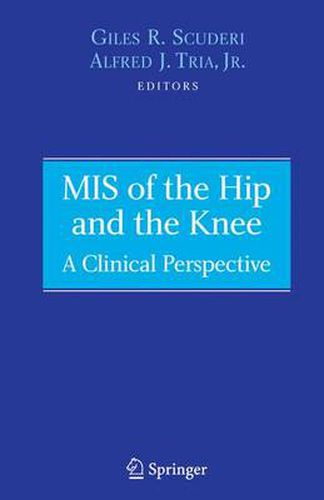Readings Newsletter
Become a Readings Member to make your shopping experience even easier.
Sign in or sign up for free!
You’re not far away from qualifying for FREE standard shipping within Australia
You’ve qualified for FREE standard shipping within Australia
The cart is loading…






This title is printed to order. This book may have been self-published. If so, we cannot guarantee the quality of the content. In the main most books will have gone through the editing process however some may not. We therefore suggest that you be aware of this before ordering this book. If in doubt check either the author or publisher’s details as we are unable to accept any returns unless they are faulty. Please contact us if you have any questions.
This is a new and exciting period in orthopedic surgery. Times are cha- ing,and we are developing techniques to perform joint arthroplasty through smaller and smaller incisions in an effort to reduce the amount of int- operative trauma and expedite the path to recovery. Minimally invasive surgery (MIS) leads to shorter hospital stays with quicker recoveries. The procedures may eventually be performed on an outpatient basis with an earlier return to daily activities and work. We have asked the leading world authorities in this ?eld of orthopaedics to contribute their ideas on these new techniques. Because so much of the technology is new, the authors cannot present signi?cant long-term foll- up. However, with their cooperation, we can present the most current knowledge about the ef?cacy of MIS. Thomas P. Sculco,Mark A. Hartzband, and Richard A. Berger have summarized their early experiences with m- imally invasive surgical total hip arthroplasty in a succinct manner. Paolo Aglietti, Jean-Noel A. Argenson, and David W. Murray have provided - depth impressions of the European experience with unicondylar knee arthroplasty. John A. Repicci, a pioneer in MIS knee surgery, presents his experience with unicondylar knee arthroplasty. Finally,Thomas M. Coon adds his own experience to give a glimpse into the future of MIS total knee arthroplasty. We are grateful to all of the authors and contributors to this text for their time and consideration. It is our hope that this work will be the foundation for the future of MIS total hip and knee arthroplasty.
$9.00 standard shipping within Australia
FREE standard shipping within Australia for orders over $100.00
Express & International shipping calculated at checkout
This title is printed to order. This book may have been self-published. If so, we cannot guarantee the quality of the content. In the main most books will have gone through the editing process however some may not. We therefore suggest that you be aware of this before ordering this book. If in doubt check either the author or publisher’s details as we are unable to accept any returns unless they are faulty. Please contact us if you have any questions.
This is a new and exciting period in orthopedic surgery. Times are cha- ing,and we are developing techniques to perform joint arthroplasty through smaller and smaller incisions in an effort to reduce the amount of int- operative trauma and expedite the path to recovery. Minimally invasive surgery (MIS) leads to shorter hospital stays with quicker recoveries. The procedures may eventually be performed on an outpatient basis with an earlier return to daily activities and work. We have asked the leading world authorities in this ?eld of orthopaedics to contribute their ideas on these new techniques. Because so much of the technology is new, the authors cannot present signi?cant long-term foll- up. However, with their cooperation, we can present the most current knowledge about the ef?cacy of MIS. Thomas P. Sculco,Mark A. Hartzband, and Richard A. Berger have summarized their early experiences with m- imally invasive surgical total hip arthroplasty in a succinct manner. Paolo Aglietti, Jean-Noel A. Argenson, and David W. Murray have provided - depth impressions of the European experience with unicondylar knee arthroplasty. John A. Repicci, a pioneer in MIS knee surgery, presents his experience with unicondylar knee arthroplasty. Finally,Thomas M. Coon adds his own experience to give a glimpse into the future of MIS total knee arthroplasty. We are grateful to all of the authors and contributors to this text for their time and consideration. It is our hope that this work will be the foundation for the future of MIS total hip and knee arthroplasty.